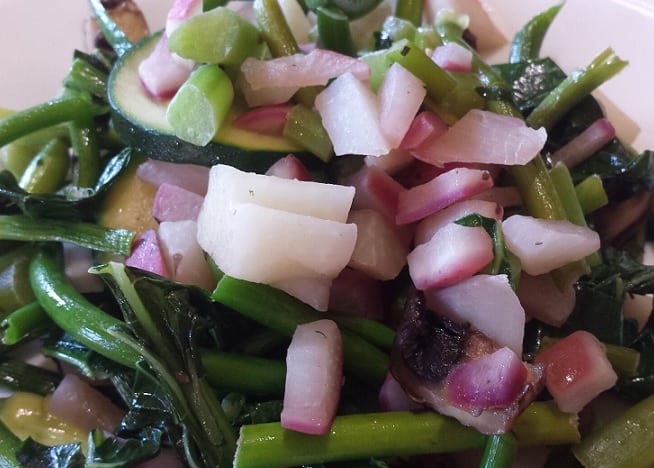One of my favorite things about summer is that I can steer away from rigid meal planning and play with what’s in season in the garden. Below is the recipe for a last minute meal I put together the other day with the harvest from Hoople Creek’s CSA basket. This lovely basket of organic, in-season veggies helps to remind me of the luxuries that many of us take for granted. If we want, we can go to the grocery store and buy virtually any food product regardless of how exotic or far it has traveled.
I find eating in season both a practice in gratitude and a challenge–just as our great grandmothers would have had to do generations ago. Even if they were affluent, they didn’t live in a globalized world and couldn’t simply run to the grocery store and pick up any fruit or vegetable their heart desired. This is why oranges were such a treat in Christmas stockings. If it wasn’t in season and there weren’t any preserves left over–people made do with what was available.
I am certainly not advocating that you do this, but the awareness of what is local and in season certainly puts our everyday luxuries back in perspective. Eating in season does have a lot of nutritional benefits as well. Eating lighter in July heat is exactly what we need. Moderate protein and light vegetables don’t weigh our digestion and metabolism down. Significant research has been conducted in this field, finding that when we eat what is in season–we are healthier.
For example, in the summer we don’t need as many complex carbohydrates to aid in serotonin production because the increased sunlight helps with this. In Dr. Elson Haas’ book Staying Healthy with the Seasons, he offers various eating plans, bodywork as well as habits to adopt during different seasons to help maintain our health and energy levels. We tend to be most tired in the fall, as sunlight decreases so more hours of sleep and gentle exercise is more energizing.
Making do with what is in season, teaches me to appreciate certain food when it available and become mindful of the Earth’s rhythms. As we all know, most of us only appreciate something when we don’t have it. This practice also gives our body exactly what we need. The first harvests of June and early July tend to be mostly green leafy vegetables, lettuce, radishes, green onions–all of the foods that our body conveniently requires for a gentle detoxification after a long Canadian winter.
Research has also found that food that is local and in season has up to three times more nutrients because it is fresh and has not been sitting in a warehouse for up to a year. We also expand our palates and branch out to try new garden bounty instead of staying in our fruit and vegetable comfort zone. Even as a nutritionist, there were still some vegetables that I would look at and think ‘What the heck and I supposed to do with that? How do you even prepare it?’ I can assure you the internet is abundant with tips and recipes. If you need another reason to eat in season–you support local farmers!
This summer I decided to focus more on writing, playing guitar and socializing more with friends so I opted to grow mostly herbs (and a few veggies). I knew I would miss the array of fresh veggies from my garden, but then remembered that I was fortunate enough to live just around the corner from an organic farm, Hoople Creek Farm. I signed up for their weekly CSA basket and now have a fresh basket of veggies every Friday. I get emails that not only give me a heads up of what will be in the basket, but that offer suggestions on what to do with the vegetables that might leave us asking ‘What do I do with this?’
I ate garlic scapes for the first time this week and thought after my first bite: “Where have you been all my life?” So without further ado–here is my In-Season Vegetable Garden Bowl from earlier this week compliments of Hoople Creek’s Farm harvest.

Ingredients:
- 2-3 tbsp butter
- 1 bunch garlic scapes, chopped
- 1/2 cucumber, sliced into disks
- 1 kohlrabi bulb, peeled and chopped
- 5-6 spring radishes, chopped
- 2 green onions, diced
- 1 bunch chopped swiss chard
- 1/2 cup chopped cilantro
*Optional–but not local or in season. Sprinkle with sesame seeds and add 2-3 tbsp coconut aminos/sauce for a thai twist.
Cooking Method:
- In a medium saucepan, add 2-3 tablespoons butter and turn element on medium-low heat
- Cook kohlrabi, spring radishes and garlic scapes for 5-7 minutes
- Add cucumber and swiss chard and cook for a few more minutes until desired tenderness
- Next add cilantro and chopped onions and cook for 2-3 minutes.
- Enjoy!
